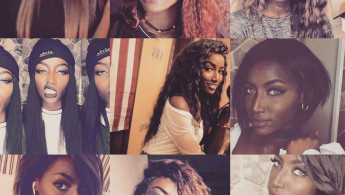Dark-skinned and beautiful: Challenging Saudi Arabia's perception of beauty
For Saudi health and beauty blogger Abeer Sinder, the issue of racism is more than just a topic to be discussed and debated, it's an issue she has dealt with since birth.
In recent weeks, Sinder's YouTube video Yes she's black.. but she's pretty has gained traction with more than a quarter of a million views in just two weeks.
The title refers to a common offensive remark made by Arabs who believe they are complimenting a 'black but pretty' woman without realising the racist undertones involved, she suggests.
"We are told that our features are ugly but it's okay because yes, you are black - but you're also pretty and bubbly and you have good energy," she told The New Arab.
"Growing up I always felt that my dark skin is beautiful and that I was pretty," she said, "but that changed when I went out into society; I started to hear so many hateful, racist comments that made me hate myself for a while... I even considered skin bleaching."
 |
Growing up I always felt that my dark skin is beautiful and that I was pretty... but that changed when I went out into society; I started to hear so many hateful, racist comments that made me hate myself for a while... I even considered skin bleaching |  |
For much of the Arab world - and some parts of south-east Asia - skin-bleaching is a daily reality, and anti-blackness is prominent, deeply entrenched and very much a taboo subject.
In fact, the sight of a dark-skinned Arab beauty blogger in the Arab world is hardly common. So rare is she that Sinder says all models, beauty bloggers and influencers she looked up to while growing up were "foreign".
"The main reason why I started blogging is because in the Middle East - Saudi Arabia to be specific - there aren't any social or public representatives of the 'black girl'," she said.
"I couldn't relate to any of the public figures and style influencers I followed, and I looked for someone with my complexion so that I can benefit from their experiences but I couldn't find any... So I decided to be that person for a lot of other black Arabs."
 |
The main reason why I started blogging is because in the Middle East – Saudi Arabia to be specific – there aren't any social or public representatives of the 'black girl' |  |
Western beauty standards
Global beauty trends often stem from the rich and powerful of the western world. White skin, blonde hair and blue eyes - for much of the Arab world - represent beauty, because those who hold any sense of real authority also hold these attributes, writer Susan Abulhawa suggests.
"That image rejects melanin-rich skin, coiled hair, broad or pointy noses, short stature, broad hips and big legs," writes Abulhawa.
"So we, too, reject these features, despising them in others and in ourselves as symbols of inferiority, laziness, and poverty. That's why the anglicising industries of skin bleaching and hair straightening are so profitable," Abulhawa notes.
For the younger generations, social media has provided an opportunity to both introduce wider viewpoints on race and the ability to interact more freely with other cultures - this is clearly demonstrated in the stream of comments found under Sinder's Instagram images and YouTube videos.
Yet despite this, social pressures stemming from the Arab worlds' elder generations insist on 'fair skin' and not much is being done to tackle these outdated ideals.
"The Arab world lacks a sustainable movement with leaders who methodically confront the issue of anti-Black racism with any sort of regularity," Dawud Walid told The New Arab.
"It's not even considered a majority societal issue to acknowledge much less confront, pertaining to bigotry that faces African immigrants and refugees, to even black Arabs," Walid added.
Follow Sana Uqba on Twitter: @Sanasiino


![President Pezeshkian has denounced Israel's attacks on Lebanon [Getty]](/sites/default/files/styles/image_684x385/public/2173482924.jpeg?h=a5f2f23a&itok=q3evVtko)



 Follow the Middle East's top stories in English at The New Arab on Google News
Follow the Middle East's top stories in English at The New Arab on Google News


